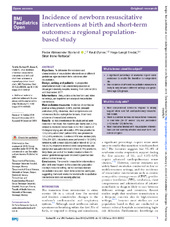| dc.contributor.author | Bjorland, Peder Aleksander | en_US |
| dc.contributor.author | Øymar, Knut | en_US |
| dc.contributor.author | Ersdal, Hege Langli | en_US |
| dc.contributor.author | Rettedal, Siren | en_US |
| dc.date.accessioned | 2020-08-11T09:18:54Z | |
| dc.date.available | 2020-08-11T09:18:54Z | |
| dc.date.issued | 2019 | |
| dc.Published | Bjorland PA, Øymar K, Ersdal HL, Rettedal S. Incidence of newborn resuscitative interventions at birth and short-term outcomes: A regional population-based study. BMJ Paediatrics Open. 2019;3:e000592 | eng |
| dc.identifier.issn | 2399-9772 | |
| dc.identifier.uri | https://hdl.handle.net/1956/23642 | |
| dc.description.abstract | Objectives: To determine the incidence and characteristics of resuscitative interventions at different gestational ages and short-term outcomes after resuscitation.
Design, setting and patients: A prospective observational study in an unselected population at Stavanger University Hospital, Norway, from October 2016 until September 2017.
Interventions: Using a data collection form and video recordings, we registered and analysed resuscitative interventions.
Main outcome measures: Incidence of continuous positive airway pressure (CPAP), positive pressure ventilation (PPV), intubation, chest compressions and intravenous fluid or epinephrine boluses. Short-term outcomes of resuscitated newborns.
Results: All 4693 newborns in the study period were included in the study. Two hundred and ninety-one (6.2%) newborns received interventions in the first minutes of life beyond drying and stimulation. PPV was provided in 170 (3.6%) while CPAP (without PPV) was provided in 121 (2.6%) newborns. Duration of PPV was median (IQR) 106 s (54–221). Intubations were performed in 19 (0.4%) newborns, with a mean (SD) intubation time of 47 (21) s. Ten (0.2%) newborns received chest compressions and epinephrine was administrated in three (0.1%) newborns. Sixty-three per cent of the treated newborns from 34 weeks’ gestational age were returned to parental care without further follow-up.
Conclusions: The need for resuscitative interventions after birth was frequent in this unselected population in a high-resource setting, but full cardiopulmonary resuscitation was rare. Short-term outcomes were good, suggesting that most newborns treated with resuscitative interventions were not severely affected. | en_US |
| dc.language.iso | eng | eng |
| dc.publisher | BMJ | eng |
| dc.rights | Attribution-Non Commercial CC BY-NC | eng |
| dc.rights.uri | http://creativecommons.org/licenses/by-nc/4.0/ | eng |
| dc.title | Incidence of newborn resuscitative interventions at birth and short-term outcomes: A regional population-based study | en_US |
| dc.type | Peer reviewed | |
| dc.type | Journal article | |
| dc.date.updated | 2020-02-05T07:36:41Z | |
| dc.description.version | publishedVersion | en_US |
| dc.rights.holder | Copyright 2019 The Authors | |
| dc.source.articlenumber | e000592 | |
| dc.identifier.doi | https://doi.org/10.1136/bmjpo-2019-000592 | |
| dc.identifier.cristin | 1780663 | |
| dc.source.journal | BMJ Paediatrics Open | |
| dc.identifier.citation | BMJ Paediatrics Open. 2019, 3 (1), e000592. | |
| dc.source.volume | 3 | |
| dc.source.issue | 1 | |

